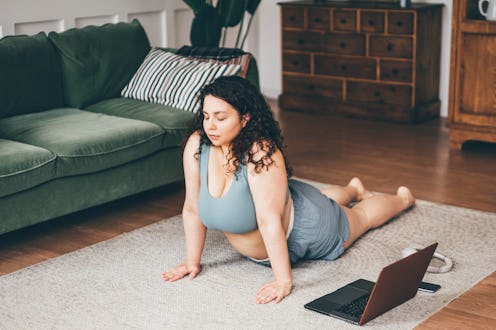Fitness
Here's How Often You Should Stretch To Improve Flexibility
Being flexible is so much more than being able to do the bendiest poses in yoga.

Bend forward to touch your toes and you might be surprised by how tight your hamstrings feel. (And your glutes, and your back.) When it’s tough to move and bend with ease, it can be a sign that you need to stretch more often in order to improve your flexibility.
To put it simply, flexibility refers to the mobility of your muscles and joints, says Austin Martinez, CSCS, a certified stretch and conditioning specialist and VP of training and experience at StretchLab. If you’re flexible, you’ll have a good range of motion, meaning you’ll be able to bend, stoop, and twist with abandon. If you aren’t flexible, you’ll likely notice that certain areas of your body feel stiff to the point where it prevents you from gettin’ down — quite literally.
When you lack flexibility, you’ll probably feel it most in your shoulders and hips. “This is because we use these areas the most during daily activities, like walking, sitting, and reaching to grab objects, so tension builds up over time,” Martinez tells Bustle. If you have pain or stiffness in these spots — or anywhere, for that matter — it likely means you need to stretch more often.
You can also do a quick at-home test to see how flexible you are, says Brandt Passalacqua, the founder, director, and lead teacher at Breathing Deeply Yoga Therapy. Start with a squat or lunge to see how your hips feel. “Being able to touch your toes or position yourself correctly for a deadlift can also help indicate if your hamstrings are flexible,” he tells Bustle. “You can then check your shoulder flexibility by lifting your arms directly over your head.”
Notice any tightness? Here’s how often you should stretch to improve flexibility.
The Benefits Of Flexibility
Your entire body is connected, so a lack of flexibility in one area can start to impact a seemingly unrelated area. Tight hips, for example, can lead to lower back discomfort, Martinez says, while tight shoulders can be a pain in the neck. If it isn’t stretched out, that tension can spread until your whole being feels like one stiff board.
Of course, being flexible doesn’t just mean you can do all the bendiest poses in yoga class. It also helps you out in everyday life. By improving your flexibility you’ll have a greater range of motion, which means you’ll be able to reach up to high shelves, bend down to pick up your dog, and even tie your shoes without issue. Flexibility also reduces your risk of injury, especially while exercising, Passalacqua says.
“Good flexibility can also improve your performance in physical activities, such as sports or fitness routines,” he tells Bustle. “Your muscles will work better and get more blood flow if you exercise your full range of motion.”
Flexibility also plays a role in good posture, says Whitney Berger, CPT, a certified personal trainer and founder of WhitFitNYC. While you need flexibility in your shoulders in order to sit up straight, that extra mobility also helps combat all the negative side effects of sitting, especially if you do it all day for work.
How Often Should You Stretch To Improve Flexibility?
In order to increase your flexibility, Passalacqua recommends stretching at least two to three times a week. “As you stretch, your connective tissues should become less restrictive and more stabilized,” he says. “If you don’t practice often enough, you may start to lose mobility again.”
Be sure to hold your stretches for at least 30 seconds each for best results, says Passalacqua. “This can help improve the plasticity in your connective tissues and result in real improvement, rather than just a feeling of release,” he explains. “But don’t push so hard or hold so long that you experience pain.”
Of course, how often you stretch depends on what you’re trying to achieve. “If you want to do a split, that is something you need to work on daily,” Berger says. If you want to improve your overall joint health and stretch, two to three times a week is great. Berger recommends stretching for a total of 30 minutes, but notes that even five or 10 minutes is OK. “You don't have to spend hours stretching to see a change,” Martinez adds. When it comes to flexibility, it’s more about finding what works for you so you can stick to a routine. “Make a plan, form it as a habit, and stick to it,” he says.
Note that you won’t be as limber as Gumby after one stretching session. According to Passalacqua, the results of your flexibility training will depend on your unique body, current mobility, and stretching routine. “If you stretch two to three times per week, you may start noticing an increase in your flexibility within the first week or two, or it may take a little longer. Be patient with yourself and if you’re worried that you are not stretching properly, consult an expert for guidance.”
Studies referenced:
Afonso, J. (2021). Strength Training versus Stretching for Improving Range of Motion: A Systematic Review and Meta-Analysis. Healthcare, 9(4). https://doi.org/10.3390/healthcare9040427
Hotta, K. (2018). Daily muscle stretching enhances blood flow, endothelial function, capillarity, vascular volume and connectivity in aged skeletal muscle. J Physiol. 2018 May 15;596(10):1903-1917. doi: 10.1113/JP275459. Epub 2018 Apr 5. PMID: 29623692; PMCID: PMC5978284.
Macefield, VG. (2018). Functional properties of human muscle spindles. J Neurophysiol. doi: 10.1152/jn.00071.2018.
Sources:
Austin Martinez, CSCS, certified stretch and conditioning specialist, VP of training and experience at StretchLab
Brandt Passalacqua, founder, director, lead teacher at Breathing Deeply Yoga Therapy
Whitney Berger, CPT, certified personal trainer, founder of WhitFitNYC